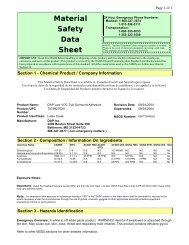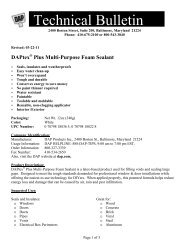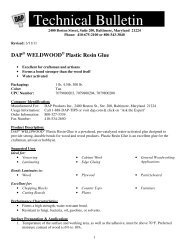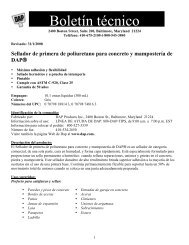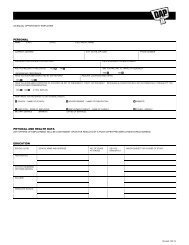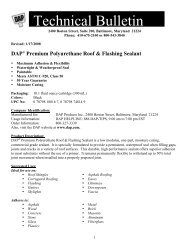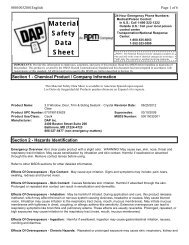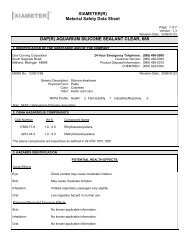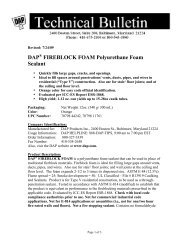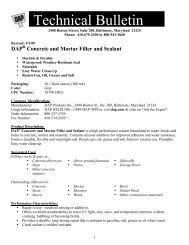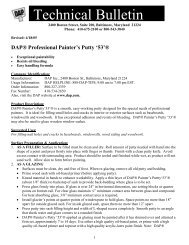00030202 - Dap
00030202 - Dap
00030202 - Dap
You also want an ePaper? Increase the reach of your titles
YUMPU automatically turns print PDFs into web optimized ePapers that Google loves.
<strong>00030202</strong>001English<br />
Page 4 of 7<br />
If airborne contaminants are generated when the material is heated or handled, sufficient ventilation in volume and air flow<br />
patterns should be provided to keep air contaminant concentration levels below acceptable criteria.<br />
Respiratory Protection: In case of insufficient ventilation, wear suitable respiratory equipment. If concentrations exceed the<br />
exposure limits specified, use of a NIOSH-approved supplied air respirator is recommended. Where the protection factor is<br />
exceeded, use of a Self Contained Breathing Apparatus (SCBA) may be necessary. A respiratory protection program that meets<br />
the OSHA 1910.134 and ANSI Z88.2 requirements must be followed whenever workplace conditions warrant a respirator's use.<br />
Skin Protection: Solvent-resistant gloves.<br />
Eye Protection: Goggles or safety glasses with side shields.<br />
Other protective equipment: Provide eyewash and solvent impervious apron if body contact may occur.<br />
Hygienic Practices: Remove and wash contaminated clothing before re-use.<br />
Section 9 - Physical And Chemical Properties<br />
Boiling Range: Not Established Vapor Density: Heavier Than Air<br />
Odor: Strong Solvent Odor Threshold: Not Established<br />
Color: Tan Evaporation Rate: Faster Than n-Butyl Acetate<br />
Solubility in H2O: Not Established Specific Gravity: 0.85<br />
Freeze Point: Not Established pH: Not Applicable<br />
Vapor Pressure: Not Established Viscosity: Not Established<br />
Physical State: Liquid Flammability: Extremely Flammable<br />
Flash Point, F: -50 F Method: (Seta Closed Cup)<br />
Lower Explosive Limit, %: Not Determined Upper Explosive Limit, %: Not Determined<br />
When reported, vapor pressure of this product has been calculated theoretically based on its constituent makeup and has not been determined experimentally.<br />
(See section 16 for abbreviation legend)<br />
Section 10 - Stability And Reactivity<br />
Conditions To Avoid: Excessive heat and freezing. Avoid contact with skin, eyes and clothing. Keep away from open flames, hot<br />
surfaces and sources of ignition. Keep away from oxidizing agents, strongly alkaline and strongly acid materials in order to avoid<br />
exothermic reactions.<br />
Incompatibility: Incompatible with strong bases and oxidizing agents. Avoid contact with strong acids and oxidizable organic<br />
materials in the presence of heat. Incompatible with open flames, hot surfaces and sources of ignition.<br />
Hazardous Decomposition Products: Normal decomposition products, i.e., COx, NOx.<br />
Hazardous Polymerization: Hazardous polymerization will not occur under normal conditions.<br />
Stability: Stable under recommended storage conditions.<br />
Section 11 - Toxicological Information<br />
Product LD50: Not Established<br />
Product LC50: Not Established<br />
CASRN Chemical Name LD50 LC50<br />
108-88-3 Toluene ------------- Rat:49 gm/m3/4H<br />
67-64-1 Acetone ------------- Rat:50100 mg/m3/8H<br />
142-82-5 n-Heptane ------------- Rat:103 gm/m3/4H<br />
108-87-2 Methylcyclohexane Mice:2250 mg/kg MIC:41500 mg/m3/2H<br />
Significant Data with Possible Relevance to Humans: None.



